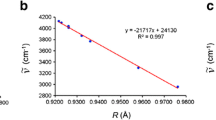Abstract
The Hellmann-Feynman theorem provides a straightforward interpretation of noncovalent bonding in terms of Coulombic interactions, which encompass polarization (and accordingly include dispersion). Exchange, Pauli repulsion, orbitals, etc., are part of the mathematics of obtaining the system’s wave function and subsequently its electronic density. They do not correspond to physical forces. Charge transfer, in the context of noncovalent interactions, is equivalent to polarization. The key point is that mathematical models must not be confused with physical reality.





Similar content being viewed by others
References
Schneider H-J (2009) Angew Chem Int Ed 48:3924–3977
Arunan E, Desiraju GR, Klein RA, Sadlej J, Scheiner S, Alkorta I, Clary DC, Crabtree RH, Dannenberg JJ, Hobza P, Kjaergaard HG, Legon AC, Mennucci B, Nesbitt DJ (2011) Pure Appl Chem 83:1619–1636
Hobza P, Müller-Dethlefs K (2010) Non-covalent interactions: theory and experiment. Royal Society of Chemistry, Cambridge
Nagy PI (2014) Int J Mol Sci 15:19562–19633
Politzer P, Murray JS (2013) ChemPhysChem 14:278–294
Politzer P, Murray JS, Clark T (2013) Phys Chem Chem Phys 15:11178–11189
Politzer P, Murray JS, Clark T (2014) Topics Curr Chem. doi:10.1007/128_2014_568
Stewart RF (1979) Chem Phys Lett 65:335–342
Politzer P, Truhlar DG (eds) (1981) Chemical applications of atomic and molecular electrostatic potentials. Plenum, New York
Klein CL, Stevens ED (1988) In: Liebman JF, Greenberg A (eds) Structure and reactivity. VCH, New York, pp 25–64
Bader RFW, Carroll MT, Cheeseman JR, Chang C (1987) J Am Chem Soc 109:7968–7979
Politzer P, Murray JS (1998) J Mol Struct (Theochem) 425:107–114
Politzer P, Murray JS (2002) Theor Chem Acct 108:134–142
Murray JS, Politzer P (2011) WIREs Comput Mol Sci 1:153–163
Mo Y, Bao P, Gao J (2011) Phys Chem Chem Phys 13:6760–6775
Riley KE, Hobza P (2008) J Chem Theory Comput 4:232–242
Palusiak M (2010) J Mol Struct (Theochem) 945:89–92
Schrödinger E (1926) Ann Phys 80:437–490
Güttinger P (1932) Z Phys 73:169–184
Pauli W (1933) Handbuch der Physik, 24. Springer, Berlin, p 162
Hellmann H (1933) Z Phys 85:180–190
Feynman RP (1939) Phys Rev 56:340–343
Musher JI (1966) Am J Phys 34:267–268
Levine IN (2000) Quantum chemistry, 5th edn. Prentice-Hall, Upper Saddle River
Fernandez Rico J, López R, Ema I, Ramírez G (2005) J Chem Theory Comput 1:1083–1095
Hirschfelder JO, Curtiss CF, Bird RB (1954) Molecular theory of gases and liquids. Wiley, New York
Berlin T (1951) J Chem Phys 19:208–213
Slater JC (1972) J Chem Phys 57:2389–2396
Bader RFW (2006) Chem Eur J 12:2896–2901
Salem L, Wilson EB Jr (1962) J Chem Phys 36:3421–3427
Hirschfelder JO, Eliason MA (1967) J Chem Phys 47:1164–1169
Fernandez Rico J, López R, Ema I, Ramírez G (2004) Int J Quantum Chem 100:221–230
Deb BM (1981) In: Deb BM (ed) The force concept in chemistry. Van Nostrand Reinhold, New York, pp ix–xiv (Preface)
Scerri ER (2000) J Chem Ed 77:1492–1494
Hennemann M, Murray JS, Politzer P, Riley KE, Clark T (2012) J Mol Model 18:2461–2469
Solimannejad M, Malekani M, Alkorta I (2010) J Phys Chem A 114:12106–12111
Scheiner S (2011) J Chem Phys 134:164313, 1–9
Politzer P, Riley KE, Bulat FA, Murray JS (2012) Comput Theor Chem 998:2–8
Clark T, Murray JS, Politzer P (2014) Aust J Chem 67:451–456
Clark T, Politzer P, Murray JS (2015) WIREs Comp Mol Sci. doi:10.1002/wcms.1210
Murray JS, Lane P, Politzer P (2007) Int J Quantum Chem 107:2286–2292
Solimannejad M, Gharabaghi M, Scheiner S (2011) J Chem Phys 134:24312, 1–6
London F (1937) Trans Faraday Soc 33:8–26
Bader RFW, Chandra AK (1968) Can J Chem 46:953–966
Hunt KLC (1990) J Chem Phys 92:1180–1187
Eisenschitz R, London F (1930) Z Phys 60:491–527
Hohenberg P, Kohn W (1964) Phys Rev B 136:864–871
Morokuma K, Kitaura K (1981) In: Politzer P, Truhlar DG (eds) Chemical applications of atomic and molecular electrostatic potentials. Plenum, New York, pp 215–242
Reed AE, Curtiss LA, Weinhold F (1988) Chem Rev 88:899–926
Sokalski WA, Roszak SM (1991) J Mol Struct (Theochem) 234:387–400
Scheiner S (1991) In: Lipkowitz KB, Boyd DB (eds) Reviews in computational chemistry, vol 2. VCH, Weinheim, pp 165–218
Stone AJ, Misquitta AJ (2009) Chem Phys Lett 473:201–205
Azar RJ, Horn PR, Sundstrom EJ, Head-Gordon M (2013) J Chem Phys 138:84102–84115
Wang W, Wang NB, Zheng W, Tian A (2004) J Phys Chem A 108:1799–1805
Murray JS, Concha MC, Lane P, Hobza P, Politzer P (2008) J Mol Model 14:699–704
Hermansson K (2002) J Phys Chem A 106:4695–4702
Qian W, Krimm S (2002) J Phys Chem A 106:6628–6636
Isaacson W (2007) Einstein: his life and universe. Simon and Schuster, New York, p 549
Bondi A (1964) J Phys Chem 68:441–451
Rowland RS, Taylor R (1996) J Phys Chem 100:7384–7391
Author information
Authors and Affiliations
Corresponding author
Additional information
This paper belongs to Topical Collection 6th conference on Modeling & Design of Molecular Materials in Kudowa Zdrój (MDMM 2014)
Rights and permissions
About this article
Cite this article
Politzer, P., Murray, J.S. & Clark, T. Mathematical modeling and physical reality in noncovalent interactions. J Mol Model 21, 52 (2015). https://doi.org/10.1007/s00894-015-2585-5
Received:
Accepted:
Published:
DOI: https://doi.org/10.1007/s00894-015-2585-5




